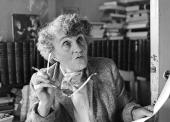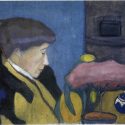Helga (Moa) Martinson was the daughter of an unmarried textile worker and trained as a sandwich maker before she moved in with a paviour, Karl Johansson, who was the father of the five sons she bore between 1910 and 1916. In 1922 she began to write for the anarchist left-wing press and in 1927 met Harry Martinson, at that time a poor vagabond poet, who from 1929 to 1941 became her second husband. Pigmamma. Roman ur arbetarkvinnornas värld, written from 1924 to 1925, was published in 1927 in serial form in the anarchist periodical Brand. Her debut book, Kvinnor och äppelträd (1933; Eng. tr. Women and Apple Trees) introduced a new element to Swedish literature, namely the body of the mother, a pivotal element of proletarian experience.
Moa Martinson worked with different genres in the 1930s to find a language to describe women’s lives at the bottom of society. Her poetry collection Motsols, 1937, her novels Sallys söner, 1934, Rågvakt, 1935, and Drottning Grågyllen, 1937, examine the primitivistic trend of the period by focusing on the complications of sexuality for women, in similar fashion to the trilogy about a proletarian girl’s development and relationship to her mother and stepfarther: Mor gifter sig (1936; Eng. tr. My Mother Gets Married), Kyrkbröllop, 1938, and Kungens rosor, 1939.
In the early 1940s, she won a many readers when her novels were brought in the form of Bild’s paperbacks by the publishing house Folket. At the same time, she travelled around and held lectures in public parks and meeting houses throughout Sweden. Her eastern Gotland epic Vägen under stjärnorna, 1940, Brandliljor, 1941, and Livets fest, 1949, are based on Gösta Berlings Saga. Here, she describes how country folk are exploited by industrialism, and how women fall into a difficult situation. Their work on the land is important, while factories ruthlessly exploit and devalue female labour. Her novels about the character of Betty, a female worker in the 1910s, Den osynlige älskaren, 1943, Du är den enda, 1952, Klockorna vid Sidenvägen, 1957, and Hemligheten, 1959, examine a female consciousness through an inner monologue. Moa Martinson was awarded the Samfundet De Nio Prize in 1944.




